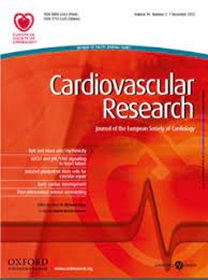双链 DNA 通过环 GMP-AMP 合成酶增强血小板活化、血栓形成和心肌损伤。
IF 10.2
1区 医学
Q1 CARDIAC & CARDIOVASCULAR SYSTEMS
引用次数: 0
摘要
目的STEMI 患者体内 dsDNA 水平升高与梗死面积增大和临床预后恶化有关。然而,dsDNA 对血小板活化的直接影响仍不清楚。方法和结果分析临床样本发现,STEMI 患者血浆中的 dsDNA 水平升高,与血小板聚集和中性粒细胞胞外捕获物(NET)标记物(如 MPO-DNA 和 CitH3)呈正相关。血小板测定显示,STEMI 患者血小板中的 cGAS-STING 通路被激活。DsDNA 可直接促进血小板活化和血栓形成。使用 G150(cGAS 抑制剂)、H151(STING 抑制剂)和 MCC950(NLRP3 抑制剂)以及 cGAS-/-、STING-/- 和 NLRP3-/- 小鼠进行的机理研究表明,dsDNA 激活了 cGAS(一种以前未报道过的血小板 DNA 传感器),并诱导激活了 STING/NLRP3/caspase-1/IL-1β轴。这种级联反应增强了血小板的活化和血栓的形成。血小板cGAS耗竭或Palbociclib(一种经FDA批准用于晚期乳腺癌的cGAS-STING抑制剂)可改善以高脂肪饮食喂养12周的载脂蛋白E-/-小鼠的心肌缺血再灌注损伤。透视-高位心肌梗死(STEMI)患者表现出高水平的血浆双链 DNA(dsDNA),它通过血小板 cGAS/STING/NLRP3/caspase-1/IL-1β 信号通路直接促进血小板活化。STEMI 患者可从 cGAS 抑制剂中获益,预防血小板过度活跃和血栓形成。本文章由计算机程序翻译,如有差异,请以英文原文为准。
Double-stranded DNA enhances platelet activation, thrombosis, and myocardial injury via cyclic GMP-AMP synthase.
AIMS
Elevated dsDNA levels in STEMI patients are associated with increased infarct size and worse clinical outcomes. However, the direct effect of dsDNA on platelet activation remains unclear. This study aims to investigate the direct influence of dsDNA on platelet activation, thrombosis, and the underlying mechanisms.
METHODS AND RESULTS
Analysis of clinical samples revealed elevated plasma dsDNA levels in STEMI patients, which positively correlated with platelet aggregation and markers of neutrophil extracellular traps (NETs) such as MPO-DNA and CitH3. Platelet assays demonstrated the activation of the cGAS-STING pathway in platelets from STEMI patients. DsDNA directly potentiated platelet activation and thrombus formation. Mechanistic studies using G150 (cGAS inhibitor), H151 (STING inhibitor), and MCC950 (NLRP3 inhibitor), as well as cGAS-/-, STING-/- and NLRP3-/- mice showed that dsDNA activated cGAS, a previously unreported DNA sensor in platelets, and induced activation of the STING/NLRP3/caspase-1/IL-1β axis. This cascade enhanced platelet activation and thrombus formation. Platelet cGAS depletion or Palbociclib, a cGAS-STING inhibitor, approved by the FDA for advanced breast cancer, ameliorated myocardial ischemia-reperfusion injury in ApoE-/- mice fed with a high-fat diet for 12 weeks.
CONCLUSIONS
These results suggested that dsDNA is a novel driver of platelet activation and thrombus formation in STEMI patients.
TRANSLATIONAL PERSPECTIVE
ST-elevated myocardial infarction (STEMI) patients exhibit high levels of plasma double-stranded DNA (dsDNA), which directly potentiates platelet activation through the platelet cGAS/STING/NLRP3/caspase-1/IL-1β signaling pathway. STEMI patients may benefit from cGAS inhibition in the prevention of platelet hyperactivity and thrombus formation.
求助全文
通过发布文献求助,成功后即可免费获取论文全文。
去求助
来源期刊

Cardiovascular Research
医学-心血管系统
CiteScore
21.50
自引率
3.70%
发文量
547
审稿时长
1 months
期刊介绍:
Cardiovascular Research
Journal Overview:
International journal of the European Society of Cardiology
Focuses on basic and translational research in cardiology and cardiovascular biology
Aims to enhance insight into cardiovascular disease mechanisms and innovation prospects
Submission Criteria:
Welcomes papers covering molecular, sub-cellular, cellular, organ, and organism levels
Accepts clinical proof-of-concept and translational studies
Manuscripts expected to provide significant contribution to cardiovascular biology and diseases
 求助内容:
求助内容: 应助结果提醒方式:
应助结果提醒方式:


